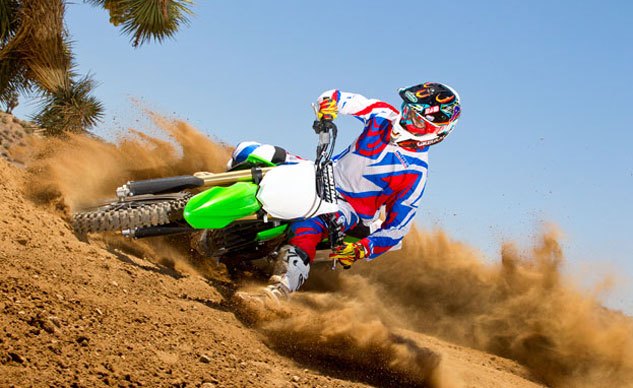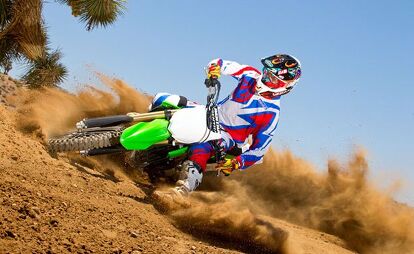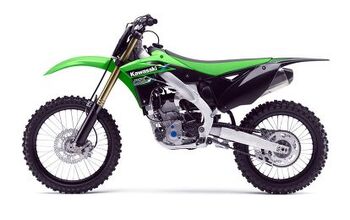2014 Kawasaki KX250F & KX450F Review
For 2014 the Kawasaki KX250F receives an array of upgrades for the new model year, while the KX450F gets a pair of slimmer stock handgrips and new graphics. We got a chance to swing a leg over both machines as part of a two-day media event at Competitive Edge MX Park in Hesperia, California.
To give both bikes a thorough test, we enlisted the services of WORCS and SCORE Baja off-road racer Ryan Abbatoye. Abbatoye was recently tapped by factory KTM rider Kendall Norman to race the Tecate SCORE Baja 500, and the pair carded a runner-up finish in the motorcycle class. After a full day of riding the KX450F, Abbatoye, turned his attention to the KX250F and had a blast on it.
Engines
The biggest mechanical change to the 2014 KX250F is its five-speed transmission gears feature four shift dogs instead of three, along with shift-fork grooves to promote a more direct feel at the shift lever. Otherwise, the KX250F’s high-revving 249cc, liquid-cooled DOHC four-stroke engine is mostly unchanged, which is fine because it was already renowned for its excellent torque and hard-hitting power.
All of the strengths that the KX450F enjoyed in 2013 return for 2014. For starters, the Kawasaki brings a hearty 449cc, liquid-cooled, DOHC, four-stroke Single to the party. It uses a works-based bridged-box-bottom piston designed to maintain rigidity, while its crankshaft is balanced to the specs of Ryan Villopoto’s factory KX450F in order to reduce vibration and provide ideal inertial mass for optimum rear-wheel traction.
The 250’s bottom end features a beefy crank mated to a thick-stem connecting rod in that is said to resist flex, while the boxed bottom on the 250’s short-profile piston helps the piston to maintain rigidity at screaming high revs. In order to reduce drag, the piston also gets a special plating to minimize friction with the 250F’s Niksail-plated bore. The KX250F also features a crankcase oil jet that delivers a stream of oil to cool the underside of the piston for better heat management.
VIEW: Read our review of the 2013 Kawasaki KX250F
The KX250F’s Digital Fuel Injection (DFI) incorporates a Keihin dual-injector, 43mm throttle body designed to keep the KX idling smoothly, and its progressive throttle linkage is claimed to enhance low-end response.
Low end is fine, but Abbatoye found that it was more effective when he kept the engine spinning at high revs. The KX250F is up to the task, with an excellent upper midrange hook and plenty of top-end power for tackling large obstacles. What was even more noticeable, however, is the addition of Kawasaki’s Launch Control system on the KX250F – a first for the 250cc class.
The Launch Control can be activated by pushing a button on the left handlebar while stopped, in neutral, first or second gear. The rider can then crank the throttle open and release the clutch aggressively when the starting gate falls. The Launch Control retards ignition timing in first and second gears to minimize wheelspin and improve drive off the line. Shifting into third gear automatically deactivates the Launch Control and returns the ignition to normal mapping.
Abbatoye was more consistent with the Launch Control engaged, and he reported that using the system allowed him to concentrate on other aspects of his starting technique besides feathering the clutch. There was no need to worry about smoking the tire off the slick starting pad, and that should make getting consistently good starts easier for most riders. It’s an excellent system that is as welcome on the KX250F as it was in the 450F.
Fuel is fed to the 450cc KX by a 43mm Keihin throttle body with Digital Fuel Injection (DFI) that features an ultra-fine atomizing injector with 12 holes that spray fine particles for excellent fuel atomization, which contributes to the KX’s smooth power delivery and crisp throttle response. The system uses two linked shafts so that the throttle body opens more quickly after reaching the 3/8 open position.
After a full day of riding at Competitive Edge, Abbatoye says the 450 delivers a wealth of low-end punch right at the hit of the throttle, blasting cleanly out of corners with authority and making it easy to set up for obstacles with a short run-up, such as supercross-style triple jumps. Tractability in stock form is excellent, and the KX450’s swappable ignition coupler caps provide a good way to tailor the power to suit track conditions.
In tacky, high-traction loam, opt for the Soft Terrain cap to unleash the full power of the KX450F to the rear wheel. Harder and/or slicker tracks can be managed by switching to the Hard Terrain cap, which will pull ignition timing to limit wheel spin. The Stock cap is designed to provide the best of all worlds. The ECU is also fully re-programmable and custom maps can be created using Kawasaki’s accessory Racing Software Calibration Kit.
Suspension
Kawasaki introduced the 48mm Kayaba Pneumatic Spring Fork (PSF) on its 2013 KX450F, relying solely on pressurized air to act as the “spring” instead of traditional coil springs. Kawasaki claims that the design shaves 1.7 lbs. of weight from the front end and improves the fork’s ability to follow terrain contours thanks to reduced internal friction. It’s also supposed to be easier to tune using the supplied high-pressure hand pump, which is similar to a mountain bike shock pump.
With no springs to grind against the inside of the fork tubes, PSD reduces oil contamination. The outer surfaces of the inner fork tubes wear a super-hard Diamond-Like Carbon (DLC) coating, while a high-tech Kashima Coat treatment on the inner surface of the outer fork tubes is used to reduce drag for more supple action.
COMPETITION: Read our review of the 2014 Honda CRF450R
The KX450F’s Kayaba shock matches the fork’s excellent performance on the motocross track. Motorcycle suspension has been moving toward larger pistons, better low-speed sensitivity and good compression feel under braking, and the KX’s shock sports a beefy 50mm piston for that reason, along with a Kashima Coat surface treatment on the inside walls of the shock body to further reduce drag. It also offers plenty of tuning options, with 33-position rebound damping, 22-position high-speed compression damping and step-less low-speed damping adjustability.
If there was one area where Abbatoye felt that the 250 held an advantage over the 450, it was in the suspension. The KX250F uses a 48mm Showa Separate Function Fork (SFF) with 40-way spring preload adjustability, 22-position compression and 20-position rebound damping adjustability. Out back, a Showa shock features 9-position low-speed and stepless high-speed compression damping, along with 22-position rebound damping and fully adjustable spring preload. Front and rear travel figures are 12.4 inches and 12.2 inches, respectively.
The SFF works well and offers easier adjustability than the Kayaba PSD air fork used on the KX450F. The SFF is still a coil spring-based fork, although it uses a single spring in the right leg while the left leg features a damping cartridge with 30mm main and 35mm sub-pistons that have been re-tuned for 2014 to improve damping performance through the initial and mid-stroke.
It was more than up to the task of hammering the KX250F through whoops and landing Comp Edge’s monster jumps with complete control, but what we liked even more was how easy it is to adjust the fork preload, thanks to the SFF’s external adjuster. Such adjustability may be commonplace on streetbikes, but tailoring front-end sag on traditional dirtbikes has usually meant cracking open the forks to replace the springs. The SFF fork changes that by allowing riders to make sag adjustments with the turn of a screw at the top of the fork. It’s a welcome feature, and one of the reasons that we prefer the SFF to conventional coil spring cartridge forks and even the KX450F’s air fork.
Chassis
Abbatoye feels that the 450’s aluminum perimeter chassis may not exhibit the razor-precise cornering of Honda’s CRF450F and Suzuki’s RM-Z450, but the KX450F can still carve a tight line and will go wherever it is pointed with no major issues. On the other hand, its high-speed stability is never in doubt no matter how fast you’re going or how rough the terrain.
The KX also excels in braking. Kawasaki introduced new brakes on the 2013 450F that were worlds better than the 2012 model, and the 2014 model gets the same petal-style 250mm front rotor and twin-piston caliper up front and 240mm petal-style rear rotor gripped by a single-piston rear caliper. The brakes offer a strong stopping power with a linear feel and just-right sensitivity.
The 250F’s aluminum perimeter frame boasts narrow frame spars for a slim feel, and it’s a stable-yet quick-turning chassis. The 250F’s low center of gravity makes shredding berms or tracking through rutted corners a breeze without compromising stability. The only change for 2014 is a switch to high-tensile steel front engine mount plates that are 29% thinner than last year’s steel plates. According to Kawasaki, the thinner plates strike a happier compromise among chassis rigidity, feedback and front-end grip. According to Abbatoye, the KX250F feels as if it’s on rails.
COMPETITION: Read our review of the 2011 Honda CRF250R
It also feels small. The 250F’s side covers are tiny and form a smooth line with the airbox for easy fore and aft movement. The seat/tank interface is also designed for better freedom of movement and forward weight placement for better cornering. For 2014, The KX250F’s ergonomics have been slightly enhanced via new grips that feature a low-density compound that should offer a better feel and fewer blisters.
Styling
The KX450’s new graphics are augmented by an anodized blue finish on the oil cap and two caps on the generator cover to give the bike more of a “factory” appearance. These items match the blue anodized finish on the suspension adjusters, while a “K” logo on the clutch cover looks trick and is also designed to help hide signs of wear.
The KX250F’s new graphics match the 450F’s more than ever, with a new white rear fender to go along with the an anodized blue finish on the oil cap, two caps on the generator cover and on the suspension adjusters. Its clutch cover is designed like the 450’s.
We came away impressed with both 2014 KXs. We expect the 250 to be right in the thick of the battle for top honors in the 250cc motocross class for 2014. The “Blue Crew” is attacking the class with a vengeance in the form of an almost completely new YZ250F, but it’s going to have to be pretty darn good if it hopes to beat the KX250F.
In the 450 class, only time will tell whether other slightly revised models such as the CRF450R and the RM-Z450 will match the Kawasaki’s pace, or if Yamaha’s new YZ450F comes in and steal their thunder.
Check out our full 2014 Kawasaki KX250F and KX450F photo gallery here.
More by Scott Rousseau










































Comments
Join the conversation
Too bad the KLR650 still use carburetor and for this reason can not be sold here in Brazil!